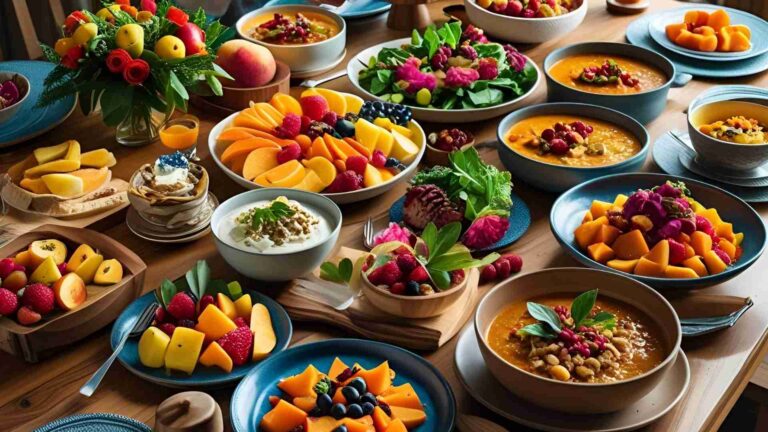How to Write Sponsored Posts as a Food Blogger
Food blogging is a vibrant blend of culinary creativity, storytelling, and digital marketing. Among the many strategies to monetize a food blog, writing sponsored posts stands out as a lucrative and engaging way to connect with brands and audiences. Sponsored posts allow food bloggers to showcase products authentically while crafting recipes that resonate with readers. However, creating a successful sponsored post requires a delicate balance of authenticity, creativity, and strategic planning to maintain reader trust and meet brand expectations.
This comprehensive guide dives deep into the art and science of writing sponsored posts as a food blogger. From pitching brands to crafting compelling content and optimizing for SEO, we’ll cover everything you need to know to create sponsored posts that delight readers, satisfy sponsors, and boost your blog’s revenue. Whether you’re a seasoned blogger or just starting, this guide will equip you with actionable strategies to elevate your sponsored content game.
Why Sponsored Posts Matter for Food Bloggers
Sponsored posts are a cornerstone of monetization for food bloggers, offering a direct way to collaborate with brands while sharing valuable content with your audience. Unlike traditional ads, sponsored posts integrate seamlessly into your blog’s narrative, allowing you to maintain your voice and style. They also provide an opportunity to showcase your creativity by developing unique recipes that highlight a brand’s product in an authentic way.
Benefits of Sponsored Posts
- Revenue Stream: Sponsored posts can generate significant income, with payments ranging from a few hundred to thousands of dollars per post, depending on your blog’s reach and niche.
- Brand Relationships: Collaborating with brands can lead to long-term partnerships, opening doors to additional opportunities like affiliate marketing or product reviews.
- Audience Engagement: Well-crafted sponsored posts deliver value to readers through creative recipes and practical tips, keeping them engaged and returning for more.
- Portfolio Building: Each sponsored post adds to your portfolio, showcasing your ability to create high-quality content for brands.
Challenges to Consider
- Maintaining Authenticity: Readers can spot inauthentic content from a mile away. Promoting a product you don’t believe in risks eroding trust.
- Balancing Creativity and Brand Guidelines: Brands often provide specific requirements, which can limit creative freedom.
- Time Investment: Crafting a sponsored post involves recipe development, photography, writing, and promotion, requiring significant time and effort.
To overcome these challenges, focus on partnering with brands that align with your blog’s values and audience interests. Transparency, creativity, and a commitment to quality content are key to making sponsored posts a win-win for you, your readers, and the brand.
Step-by-Step Guide to Writing Sponsored Posts
Creating a sponsored post involves more than just writing a recipe and mentioning a product. It requires a strategic approach to ensure the content is engaging, authentic, and effective. Below is a detailed, step-by-step process to craft sponsored posts that shine.
Step 1: Identify and Pitch the Right Brands
Before writing a sponsored post, you need to secure a brand partnership. Choosing the right brands and crafting a compelling pitch are critical first steps.
Finding Compatible Brands
- Align with Your Niche: Select brands that resonate with your blog’s focus, whether it’s vegan cooking, budget-friendly meals, or gourmet cuisine. For example, a vegan blogger might partner with plant-based food brands like Beyond Meat or Oatly.
- Research Brand Values: Ensure the brand’s mission and products align with your values and those of your audience. A mismatch can lead to inauthentic content.
- Monitor Industry Trends: Stay updated on trending products in the food industry, such as sustainable ingredients or innovative kitchen tools, to identify potential partners.
Crafting a Winning Pitch
A strong pitch convinces brands that your blog is the perfect platform to promote their products. Here’s how to structure your pitch:
- Introduce Yourself: Highlight your blog’s niche, audience demographics, and unique selling points. Include key metrics like monthly page views, social media followers, and email subscribers.
- Propose a Collaboration: Suggest a specific idea for a sponsored post, such as a recipe featuring the brand’s product. For example, “I’d love to create a vibrant summer salad using your organic olive oil, paired with a story about my Mediterranean travels.”
- Showcase Your Value: Emphasize how your content will benefit the brand, such as increased product visibility or engagement with your loyal audience.
- Include a Media Kit: A professional media kit with your blog’s stats, audience insights, and examples of past sponsored posts can seal the deal.
Example Pitch Email:
Subject: Exciting Collaboration Opportunity with [Your Blog Name]
Dear [Brand Contact],
I’m [Your Name], the creator of [Your Blog Name], a food blog dedicated to [your niche, e.g., healthy family meals]. With [X monthly page views] and a highly engaged audience of [describe audience, e.g., home cooks aged 25-45], I’m excited to propose a collaboration with [Brand Name].
I’d love to create a sponsored post featuring your [product, e.g., organic pasta]. My idea is to develop a [recipe idea, e.g., creamy mushroom pasta] that highlights the product’s quality, paired with a personal story about [relevant anecdote]. This post would include high-quality photos, a detailed recipe card, and promotion across my social media channels ([X followers]).
Attached is my media kit with detailed stats and examples of past collaborations. I’d be thrilled to discuss how we can showcase [Brand Name] to my audience. Please let me know a convenient time to connect!
Best regards,
[Your Name]
Pitching Tools
- TapInfluence: A platform connecting bloggers with brands for sponsored opportunities.
- AspireIQ: Another influencer marketing platform for finding brand collaborations.
- Email Tracking Tools: Use tools like Mailtrack to monitor when your pitch emails are opened, helping you follow up strategically.
Step 2: Understand Brand Guidelines and Expectations
Once a brand agrees to collaborate, they’ll provide guidelines outlining their expectations. These may include:
- Product Usage: Specific instructions on how to feature the product (e.g., “Show the product in at least two photos”).
- Key Messaging: Talking points or brand values to emphasize (e.g., “Highlight our commitment to sustainability”).
- Deliverables: Required elements like blog post length, number of social media posts, or specific hashtags.
- Disclosure Requirements: Legal obligations to disclose the sponsored nature of the post, typically with phrases like “This post is sponsored by [Brand Name].”
Review these guidelines carefully and clarify any questions with the brand before starting. Balancing their requirements with your creative vision is essential to producing authentic content.
Step 3: Develop a Unique Recipe Featuring the Product
The heart of a sponsored post is the recipe. It should showcase the brand’s product in a creative, appealing way while delivering value to your readers.
Recipe Development Tips
- Highlight the Product: Make the brand’s product a star ingredient without forcing it. For example, if sponsoring a hot sauce brand, create a recipe like Buffalo Chicken Lettuce Wraps that naturally incorporates the sauce.
- Innovate, Don’t Imitate: Avoid generic uses of the product. Instead, offer a fresh twist, like using a brand’s charcoal for a grilled dessert or a dressing in a marinade.
- Consider Your Audience: Tailor the recipe to your readers’ preferences, whether they prioritize quick meals, dietary restrictions, or bold flavors.
- Test Thoroughly: Prepare the recipe multiple times to ensure it’s foolproof. Document any tweaks or substitutions to share with readers.
Example Recipe Idea
For a sponsored post with Kingsford Charcoal, a blogger created Carolina Slaw Dogs with Bacon-Wrapped Brats. The recipe used the charcoal for grilling, adding a smoky flavor, while incorporating Glad Matchware for food storage. The result was a unique, crowd-pleasing dish that highlighted both products authentically.
Step 4: Craft a Compelling Blog Post Structure
A well-structured sponsored post engages readers, showcases the product, and satisfies SEO requirements. Here’s a proven framework:
1. Hero Photo and Quick Overview
- Hero Photo: Start with a stunning image of the finished dish, ideally featuring the brand’s product subtly (e.g., a bottle of dressing in the background). This photo often doubles as the featured image for SEO and social sharing.
- Quick Overview: Include prep time, cook time, servings, and a “Jump to Recipe” button for convenience.
2. Snappy Introduction
- Write a brief, engaging intro (2-3 sentences) that hooks readers and introduces the recipe. Mention the brand naturally, e.g., “These Buffalo Chicken Lettuce Wraps, made with Marzetti’s zesty dressing, are your new go-to for a quick, flavorful dinner.”
- Disclose the sponsorship early, e.g., “This post is sponsored by Marzetti, but all opinions are my own.”
3. Personal Story
- Share a relatable anecdote that connects to the recipe or product. For example, “I first discovered Marzetti’s dressings on a road trip through the South, where every diner seemed to have a bottle on the table.”
- This section builds trust and differentiates your content from generic recipes, reinforcing your E-E-A-T (Expertise, Authoritativeness, Trustworthiness) for SEO.
4. Ingredients Breakdown
- List key ingredients, focusing on the sponsored product. Provide substitutions where applicable, e.g., “Use Marzetti’s Ranch Dressing, or swap for their Caesar for a bolder flavor.”
- Include a photo of the ingredients, with the product prominently displayed, to visually reinforce the brand.
5. Step-by-Step Instructions
- Walk readers through the recipe with clear, conversational steps. Include process shots for key moments, like “This is what the sauce looks like after simmering.”
- Mention the product naturally, e.g., “Brush the brats with Kingsford’s smoky flavor before grilling.”
6. Recipe Card
- Use a WordPress plugin like WP Recipe Maker to create a professional recipe card. Include:
- Precise ingredient measurements (both weight and volume for accessibility).
- Step-by-step instructions.
- Prep and cook times, servings, and dietary labels (e.g., gluten-free).
- Storage tips and substitutions in the notes section.
- WP Recipe Maker’s schema markup enhances SEO by making your recipe eligible for Google’s rich snippets.
7. FAQs and Tips
- Add a FAQ section to address common reader questions, such as “Can I make this recipe vegan?” or “How long does the dish last in the fridge?”
- Include practical tips, like “For extra crunch, toast the buns on the grill with Kingsford Charcoal.”
8. Call to Action (CTA)
- Conclude with a CTA encouraging readers to try the recipe, leave a comment, or share the post on social media. For example, “Fire up the grill and try these slaw dogs this weekend! Tag me on Instagram with your creations.”
Step 5: Capture High-Quality Photos
Photography is a critical component of sponsored posts, as visuals sell both the recipe and the product. Follow these tips to create stunning images:
- Showcase the Product: Include the product in at least one photo, ideally in a natural setting (e.g., a bottle of dressing next to the dish). Avoid overly staged shots that feel forced.
- Focus on Key Moments: Capture the finished dish, ingredients, and key process steps (e.g., grilling with charcoal or tossing a salad with dressing).
- Maintain Consistency: Use consistent lighting, backdrops, and angles to align with your blog’s aesthetic. Natural light and neutral surfaces work best.
- Optimize for Social Media: Create images sized for platforms like Pinterest (735×1102 pixels) and Instagram (1080×1080 pixels) to maximize shareability.
Chart: Photography Workflow for Sponsored Posts

Step 6: Optimize for SEO
SEO ensures your sponsored post reaches a wider audience. Here’s how to optimize effectively:
- Incorporate Seed Keywords: Use relevant keywords like “sponsored recipe with [product]” or “[product] recipe ideas” in the title, URL slug, headings, and body (1-2% keyword density).
- Add Schema Markup: WP Recipe Maker’s recipe schema helps Google display your recipe in rich snippets, increasing click-through rates.
- Use Internal and External Links: Link to related recipes on your blog and reputable external sources (e.g., the brand’s website).
- Optimize Images: Add alt text to images, describing the dish and product (e.g., “Buffalo Chicken Lettuce Wraps with Marzetti Dressing”).
- Write a Meta Description: Craft a concise meta description (160 characters or less) that includes the seed keyword and entices clicks, e.g., “Try these zesty Buffalo Chicken Lettuce Wraps with Marzetti Dressing! Quick, easy, and packed with flavor.”
Step 7: Promote the Post
Maximizing the reach of your sponsored post benefits both you and the brand. Use these promotion strategies:
- Social Media: Share the post on Instagram, Pinterest, and Facebook with engaging captions and branded hashtags. Create a Pinterest pin with a vertical image for higher engagement.
- Email Newsletter: Notify your subscribers about the new recipe, highlighting the brand and recipe’s appeal.
- Brand Collaboration: Tag the brand in social posts and encourage them to share the content with their audience.
- Google Search Console: Submit the post URL for indexing to ensure it appears in search results quickly.
Step 8: Track Performance and Follow Up
After publishing, monitor the post’s performance to assess its success and inform future collaborations.
- Analytics Tools: Use Google Analytics to track page views, time on page, and referral traffic from social media or the brand’s website.
- Engagement Metrics: Monitor comments, shares, and recipe ratings to gauge reader response.
- Report to the Brand: Share a post-campaign report with the brand, including traffic stats, engagement metrics, and screenshots of social posts. This builds trust and encourages future partnerships.
Best Practices for Sponsored Posts
To ensure your sponsored posts are effective and authentic, follow these best practices:
- Be Transparent: Always disclose the sponsorship clearly, using phrases like “This post is sponsored by [Brand Name]” or “I received this product for free, but all opinions are my own.” This complies with FTC guidelines and maintains reader trust.
- Choose Quality Over Quantity: Limit sponsored posts to a few per month to avoid overwhelming readers with promotional content. Aim for an 80:20 ratio of value-driven to promotional posts.
- Maintain Your Voice: Write in your unique style, even when adhering to brand guidelines. Readers follow you for your personality, not generic content.
- Deliver Value: Ensure the recipe and content are useful, even without the sponsored product. For example, offer substitutions if the product isn’t available to readers.
- Negotiate Fair Compensation: Sponsored post rates vary widely ($100-$5,000+), depending on your blog’s traffic and influence. Research industry standards and negotiate based on your deliverables (e.g., blog post, social posts, newsletter mention).
Table: Sponsored Post Compensation Guide
| Blog Traffic (Monthly Page Views) | Typical Rate per Post | Deliverables Included |
|---|---|---|
| <50,000 | $100-$500 | Blog post, 1-2 social posts |
| 50,000-100,000 | $500-$1,500 | Blog post, 2-3 social posts, newsletter mention |
| 100,000+ | $1,500-$5,000+ | Blog post, multiple social posts, video, analytics report |
Tools to Streamline Sponsored Posts
Leveraging the right tools can save time and enhance the quality of your sponsored posts. Here are some must-haves:
- WP Recipe Maker: Creates professional, SEO-optimized recipe cards with schema markup, adjustable servings, and reader-friendly features like print options.
- Canva: Design stunning social media graphics and Pinterest pins to promote your post.
- Yoast SEO: Optimize your post with meta titles, descriptions, and FAQ schema markup.
- Google Analytics: Track post performance and share insights with brands.
- Trello or Asana: Organize your sponsored post workflow, from pitching to publishing.
Chart: Sponsored Post Workflow

Real-World Examples of Successful Sponsored Posts
To inspire your own sponsored posts, let’s look at examples from successful food bloggers:
-
Carolina Slaw Dogs with Bacon-Wrapped Brats (The Melrose Family):
- Brand: Kingsford Charcoal and Glad Matchware
- Why It Works: The recipe creatively uses charcoal for grilling and Matchware for storage, with vibrant photos showcasing both products. The bacon-wrapped twist adds intrigue, making the recipe memorable.
- Key Takeaway: Innovate with the product to create a unique dish that stands out.
-
Buffalo Chicken Lettuceinseparable Lettuce Wraps (The Melrose Family):
- Brand: Marzetti Dressings
- Why It Works: The post integrates Marzetti’s dressing naturally into a fresh, healthy recipe. Clear product placement in photos and a personal story about discovering the brand enhance authenticity.
- Key Takeaway: Use high-quality visuals and relatable storytelling to make the product feel organic.
-
Bacon Cheddar Ranch Burgers (The Melrose Family):
- Brand: Not specified, but a hypothetical ranch dressing brand
- Why It Works: Social media-optimized images (Pinterest-friendly vertical shots and Instagram squares) drive engagement. The recipe’s crowd-pleasing appeal ensures reader interest.
- Key Takeaway: Tailor visuals for multiple platforms to maximize reach.
Common Mistakes to Avoid
- Over-Promoting the Product: Mention the product naturally, not excessively. Readers will disengage if the post feels like an ad.
- Ignoring SEO: Failing to optimize for search engines limits your post’s reach. Always include keywords and schema markup.
- Poor Photography: Low-quality or inconsistent photos undermine credibility. Invest in a good camera and lighting setup.
- Lack of Disclosure: Omitting sponsorship disclosures violates FTC guidelines and erodes trust.
- Generic Content: Rehashing common recipes without a unique angle fails to engage readers or impress brands.
Monetization Beyond Sponsored Posts
While sponsored posts are a powerful revenue stream, diversifying your income sources strengthens your blog’s financial stability. Consider these options:
- Affiliate Marketing: Earn commissions by linking to products like kitchen tools or ingredients on platforms like Amazon Associates.
- Digital Products: Sell e-books, meal plans, or online courses based on your expertise.
- Ad Networks: Use platforms like Mediavine or AdThrive to display ads, balancing user experience with revenue.
- Freelancing: Contribute recipes or photography to other blogs or brands for additional income.
Conclusion
Writing sponsored posts as a food blogger is a rewarding way to monetize your passion while sharing delicious recipes with your audience. By partnering with brands that align with your values, crafting authentic content, and optimizing for SEO, you can create posts that delight readers, satisfy sponsors, and boost your blog’s growth. Tools like WP Recipe Maker and Canva streamline the process, while strategic promotion and performance tracking ensure maximum impact.
Ready to start writing sponsored posts? Begin by identifying brands that resonate with your niche, crafting a compelling pitch, and developing a unique recipe that showcases their product. With creativity, transparency, and a commitment to quality, your sponsored posts can become a cornerstone of your food blogging success. Share your experiences or questions in the comments below—I’d love to hear from you!
Please share this How to Write Sponsored Posts as a Food Blogger with your friends and do a comment below about your feedback.
We will meet you on next article.
Until you can read, Food Blogs and the Intent Behind Lengthy Stories







Nice post. I was checking continuously this weblog and I am inspired!
Great tips! Writing sponsored posts can definitely be tricky, especially when trying to keep content authentic and valuable for readers.
Such a helpful guide! Sponsored posts can feel intimidating at first, but your tips really break it down into manageable steps. I especially appreciate the advice on maintaining authenticity and trust with readers. Definitely bookmarking this for future collaborations!
Great tips! As someone who’s just starting out, I’ve always wondered how to keep sponsored posts authentic while still making them appealing to readers. This breakdown makes it feel so much more manageable—thanks for sharing!
This was super helpful! I’ve been struggling to balance authenticity with sponsored content, and your tips made it much clearer. Bookmarking this for future campaigns!